用语as well 与as well as用法归纳
- 格式:doc
- 大小:33.50 KB
- 文档页数:2

as well as用法及作用As Well As 用法及作用As well as 是一个常见的词组,它在英语中具有多种用法和作用。
在本文中,我们将详细讨论 as well as 的用法以及它在句子中的作用。
一、用法解析1. 作为连接词As well as 在句子中起到连接两个并列成分的作用,与 and 类似。
它表示“和……一样,以及”、“还有”、“除了……之外”,用于列举、句中插入或对比等情况。
下面是一些例句:- I study English, as well as French and German.(我学习英语,还学法语和德语。
)- She is good at playing the piano, as well as the violin.(她不仅擅长弹钢琴,还擅长拉小提琴。
)- The company offers employees various benefits, as well as a competitive salary.(公司为员工提供各种福利,除了竞争力的薪酬外。
)2. 强调和递进在句子中,as well as 可以用来强调或递进前面说到的事物。
它在这种用法下相当于 also 或 furthermore。
以下是例句:- I'm not only a doctor, but a writer as well.(我不仅仅是个医生,也是个作家。
)- He can not only speak English fluently, but also French as well.(他不仅能说一口流利的英语,还会法语。
)- The hotel not only provides comfortable rooms, but also offers excellent dining options as well.(这家酒店不仅提供舒适的客房,还有出色的餐饮选择。
)3. 替代 or在一些情况下,as well as 可以替代 or,表示两者选择时的“也”、“又”,用于否定句中。

as well as 用法As well as 是一个常用的短语,用于引入一个附加的或者额外的信息,用于扩展句子的内容。
它通常用于英语口语和写作中,可以用于各种场景和语境中。
接下来我们将从不同的角度来介绍 as well as 的用法。
1. 作为连接副词As well as 可以作为连接副词,用于连接两个并列的词或者短语,表示它们都是同等重要的。
例如:- I enjoy playing basketball as well as football.我喜欢打篮球和踢足球。
- She is talented in both singing as well as dancing.她既擅长唱歌又擅长跳舞。
2. 作为介词As well as 也可以作为介词使用,常用于表示除了某个人或事物之外,还包括其他的人或事物。
例如:- The party was attended by my classmates as well as my family members.派对上除了我的同学,还有我的家人参加了。
- The bookstore sells not only novels, but also a variety of other books, like textbooks, as well as magazines.这家书店不仅卖小说,还有其他各种书籍,比如教科书和杂志。
需要注意的是,as well as 在这种用法中引入的内容与前面的主语不是同一个人或事物,也可以理解为连接主语与谓语部分。
3. 强调同一主体多种不同的身份或能力As well as 还可以用于强调同一主体具备多种不同的身份或能力。
例如:- Tom, as well as being a talented writer, is also a skillful painter.汤姆除了是一个有才华的作家之外,也是一个熟练的画家。
- The professor, as well as being an expert in biology, is also knowledgeable in chemistry.这位教授不仅是一个生物学专家,还在化学方面有丰富的知识。
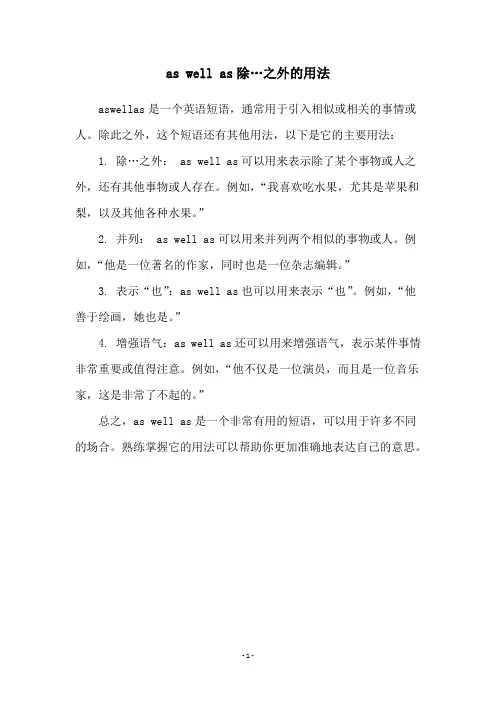
as well as除…之外的用法
aswellas是一个英语短语,通常用于引入相似或相关的事情或人。
除此之外,这个短语还有其他用法,以下是它的主要用法:
1. 除…之外: as well as可以用来表示除了某个事物或人之外,还有其他事物或人存在。
例如,“我喜欢吃水果,尤其是苹果和梨,以及其他各种水果。
”
2. 并列: as well as可以用来并列两个相似的事物或人。
例如,“他是一位著名的作家,同时也是一位杂志编辑。
”
3. 表示“也”:as well as也可以用来表示“也”。
例如,“他善于绘画,她也是。
”
4. 增强语气:as well as还可以用来增强语气,表示某件事情非常重要或值得注意。
例如,“他不仅是一位演员,而且是一位音乐家,这是非常了不起的。
”
总之,as well as是一个非常有用的短语,可以用于许多不同的场合。
熟练掌握它的用法可以帮助你更加准确地表达自己的意思。
- 1 -。

惯用语as well as用法归纳作者:mydekt 文章来源:本站原创点击数:25917 更新时间:2011-10-11 热★★★【字体:小大】惯用语as well as用法归纳一、分清本义与引申义1. 用于本义as well as 用于本义,可视为as…as结构与well的自然搭配,其意为“与……一样好”,在否定句中可用not so wellas代替 not as well as。
如:He speaks English as well as her. 他说英语说得跟她一样好。
She plays every bit as well as the men. 她打得一点不比男人们差。
He doesn’t play half as well as his sister. 他演奏的水平不及他姐姐的一半。
He sings as well as, if not better than, Mary. 要是他唱歌不比玛丽唱得更好,但至少也是一样好。
2. 用于引申义用于引申义,表示“不但……而且”“既是……也是”“而且”“还”。
如:He grows flowers as well as vegetables. 他既种菜也种花。
She shares (in) my troubles as well as my joys. 她与我同甘共苦。
They have a flat in town as well as a place in the country. 他们在城里有一套公寓,在乡村还有一所房子。
注:有时还可译为“除……之外,还”,与介词:besides, in addition to的用法相似。
如:As well as learn ing to swim he has been taking Spanish lessons this summer. 今年夏天,他除了学习游泳外,他还在上西班牙语课。
二、弄清强调重点A as well as B这一结构强调的重点是A不是B,即 A as well as B=not onlyB but also A,注意体会以下例句的译文:She is clever as well as beautiful. 她不但漂亮,而且聪明。
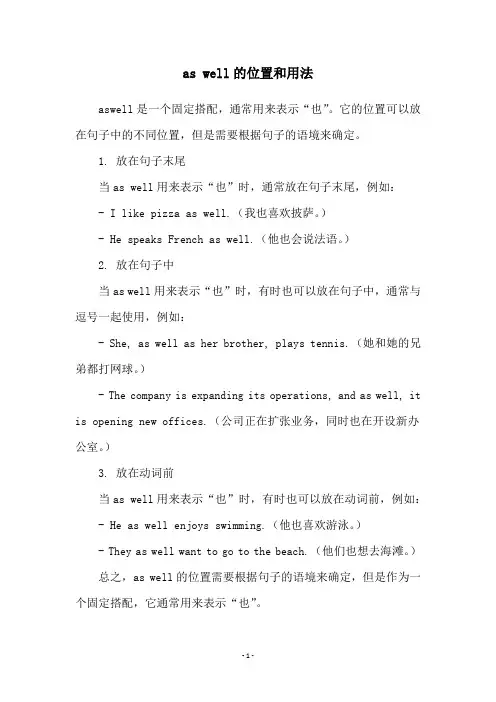
as well的位置和用法
aswell是一个固定搭配,通常用来表示“也”。
它的位置可以放在句子中的不同位置,但是需要根据句子的语境来确定。
1. 放在句子末尾
当as well用来表示“也”时,通常放在句子末尾,例如:
- I like pizza as well.(我也喜欢披萨。
)
- He speaks French as well.(他也会说法语。
)
2. 放在句子中
当as well用来表示“也”时,有时也可以放在句子中,通常与逗号一起使用,例如:
- She, as well as her brother, plays tennis.(她和她的兄弟都打网球。
)
- The company is expanding its operations, and as well, it is opening new offices.(公司正在扩张业务,同时也在开设新办公室。
)
3. 放在动词前
当as well用来表示“也”时,有时也可以放在动词前,例如: - He as well enjoys swimming.(他也喜欢游泳。
)
- They as well want to go to the beach.(他们也想去海滩。
)总之,as well的位置需要根据句子的语境来确定,但是作为一个固定搭配,它通常用来表示“也”。
- 1 -。
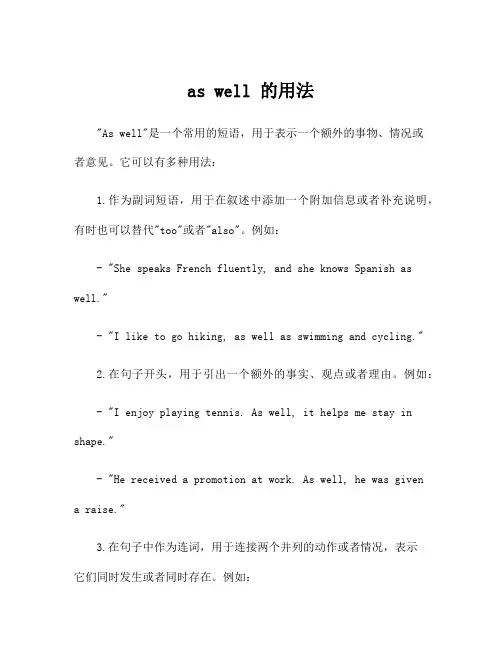
as well 的用法"As well"是一个常用的短语,用于表示一个额外的事物、情况或者意见。
它可以有多种用法:1.作为副词短语,用于在叙述中添加一个附加信息或者补充说明,有时也可以替代"too"或者"also"。
例如:- "She speaks French fluently, and she knows Spanish as well."- "I like to go hiking, as well as swimming and cycling."2.在句子开头,用于引出一个额外的事实、观点或者理由。
例如:- "I enjoy playing tennis. As well, it helps me stay in shape."- "He received a promotion at work. As well, he was givena raise."3.在句子中作为连词,用于连接两个并列的动作或者情况,表示它们同时发生或者同时存在。
例如:- "She can sing as well as dance."- "He plays the guitar as well as the piano.""As well"还可以和其他词组合使用,形成一些固定搭配,拓展了其用法:- "as well as":意思是"以及",用于添加更多的事物或者情况。
例如:"He speaks English as well as German."- "could be as well":意思是"可能也是",用于表示对某个事物或者观点的猜测。
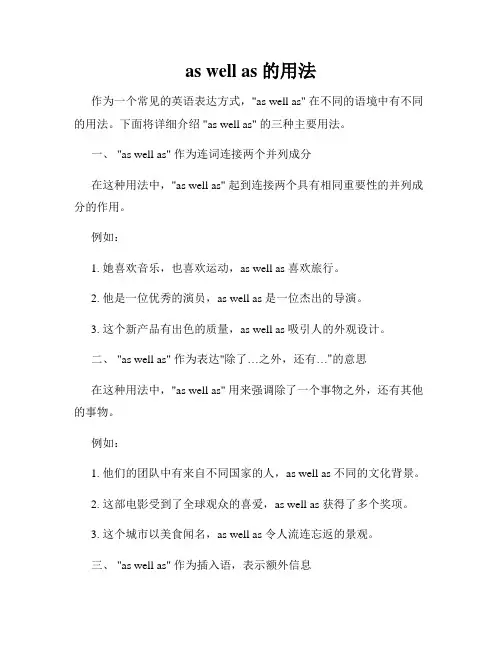
as well as 的用法作为一个常见的英语表达方式,"as well as" 在不同的语境中有不同的用法。
下面将详细介绍 "as well as" 的三种主要用法。
一、 "as well as" 作为连词连接两个并列成分在这种用法中,"as well as" 起到连接两个具有相同重要性的并列成分的作用。
例如:1. 她喜欢音乐,也喜欢运动,as well as 喜欢旅行。
2. 他是一位优秀的演员,as well as 是一位杰出的导演。
3. 这个新产品有出色的质量,as well as 吸引人的外观设计。
二、 "as well as" 作为表达"除了…之外,还有…"的意思在这种用法中,"as well as" 用来强调除了一个事物之外,还有其他的事物。
例如:1. 他们的团队中有来自不同国家的人,as well as 不同的文化背景。
2. 这部电影受到了全球观众的喜爱,as well as 获得了多个奖项。
3. 这个城市以美食闻名,as well as 令人流连忘返的景观。
三、 "as well as" 作为插入语,表示额外信息在这种用法中,"as well as" 用来引入额外的信息,通常放在句子中间。
例如:1. 我的同事,as well as 我自己,都很期待这次会议。
2. 学校的老师,as well as 家长们,都参加了这次家长会议。
3. 他的粉丝们,as well as 他的音乐,都是他成功的原因之一。
在使用 "as well as" 的过程中,需要注意一些细节。
首先,"as well as" 连接的两个成分在结构和语法上应该是对等的。
其次, "as well as" 可以位于句子的任意位置,但需要注意上下文的语义逻辑。

as well as的用法总结aswellas是英语中的一个常用的连接词,它可以在句子中起到连接两个或多个并列的词语或短语的作用,例如:He likes swimming as well as basketball. 他喜欢游泳也喜欢篮球。
可以看出,as well as可以用来连接两个表示同一类同性质的词语,它主要表示“也”或“还”的意思。
as well as可用来连接不同性质的名词和介词短语,例如:He likes swimming as well as outdoor activities. 他喜欢游泳,也喜欢户外活动。
可以看出,as well as可以用来连接两个表示不同类但性质相同的名词及介词短语,它主要表示“也”或“和”的意思。
此外,as well as还可以用来连接两个表示强调的短语或句子,例如:He likes swimming as well as running all day long. 他喜欢游泳,也一整天都在跑步。
从上例可以看出,as well as可用来表示强调两个句子的意思,它主要表示“以及”或“另外”的意思。
另外,as well as还可以用来连接两个表示补充的句子,例如: He likes swimming as well as going to the library. 他喜欢游泳,也喜欢去图书馆。
可以看出,as well as可以用来连接两个表示补充的句子,它主要表示“此外”的意思。
总的来说,as well as可以用来连接两个或多个并列的词语或短语,可以表示“也”、“还”、“以及”、“另外”和“此外”的意思。
在日常的英语的书面表达中,如果想要更准确的表达,应该学习掌握as well as的用法,在句子中有针对性的使用as well as。

as well 的用法总结"as well" 是一个常用的英语短语,具有多种用法。
以下是一些常见的用法总结:表示也、另外: "as well" 用于表示也或者另外,强调与前述内容的相关性。
* 例句:She likes chocolate, and she likes vanilla ice cream as well.用于肯定句的尾部: "as well" 也可以放在肯定句的尾部,用于强调。
* 例句:I enjoy hiking, and I like swimming as well.用于疑问句的尾部: "as well" 也可以用于疑问句的尾部,询问对方是否也在做某事。
* 例句:Are you coming to the party as well?用于表示程度: "as well" 有时可以用于强调程度,类似于"too" 或 "also"。
* 例句:He's working hard, and he's studying a lot as well.用于表示同样的事情: "as well" 也可以用于表示同样的事情正在发生。
* 例句:We need to finish the project, and we need to submit the report as well.总体而言,"as well" 是一个灵活的短语,可以用于各种语境中,强调额外的信息、程度、同样的事情等。
在使用时要根据具体语境选择合适的含义。
1。

as well as的用法一、介绍as well as的基本用法和含义在英语中,as well as是一个常见的短语,可以作为连词使用。
它起到连接两个相似或相关的事物,以及引入附加信息的作用。
其基本含义是“也”,用于强调并列关系。
例如,“He can speak English as well as French”(他既会说英语,也会说法语)。
二、表示并列关系1. 连接两个平行的主语使用as well as可以将两个平行的主语并列在一起,并且在形式上通常只有第一个主语和谓语动词之间存在一致关系。
例如,“Mary, as well as her brother, enjoys playing tennis”(玛丽和她的兄弟都喜欢打网球)。
2. 强调额外的内容除了连接两个主语外,as well as还可以用来引入附加信息或强调额外内容。
它与too 或also 的含义相似,但usually 位于句子中部。
例如,“The company provides competitive salaries, benef its, as well as a friendly work environment”(公司提供有竞争力的工资、福利和友好的工作环境)。
三、替代and的使用场景1. 强调不同类型之间的并列关系当连接两种不同类型事物时,在强调其差异性时倾向于使用as well as,而不是直接使用and。
例如,“The company offers traditional products, as well as innovative solutions”(该公司提供传统产品和创新解决方案)。
2. 强调部分与整体之间的关系在强调整体和其中一部分之间的关系时,常用as well as表示较为正式和严肃的语气。
例如,“The organization has branches in major cities around the world, as well as several small regional offices”(该组织在世界主要城市设有分支机构,并有数个小型区域办事处)。
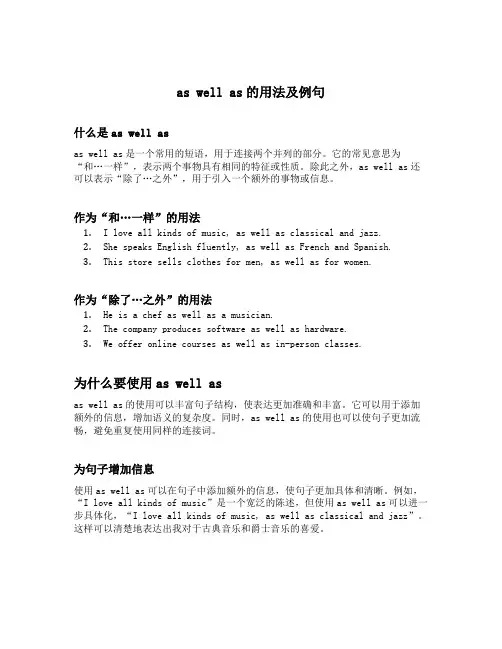
as well as的用法及例句什么是as well asas well as是一个常用的短语,用于连接两个并列的部分。
它的常见意思为“和…一样”,表示两个事物具有相同的特征或性质。
除此之外,as well as还可以表示“除了…之外”,用于引入一个额外的事物或信息。
作为“和…一样”的用法1.I love all kinds of music, as well as classical and jazz.2.She speaks English fluently, as well as French and Spanish.3.This store sells clothes for men, as well as for women.作为“除了…之外”的用法1.He is a chef as well as a musician.2.The company produces software as well as hardware.3.We offer online courses as well as in-person classes.为什么要使用as well asas well as的使用可以丰富句子结构,使表达更加准确和丰富。
它可以用于添加额外的信息,增加语义的复杂度。
同时,as well as的使用也可以使句子更加流畅,避免重复使用同样的连接词。
为句子增加信息使用as well as可以在句子中添加额外的信息,使句子更加具体和清晰。
例如,“I love all kinds of music”是一个宽泛的陈述,但使用as well as可以进一步具体化,“I love all kinds of music, as well as classical and jazz”。
这样可以清楚地表达出我对于古典音乐和爵士音乐的喜爱。
提升句子的语义复杂度通过as well as的使用,可以使句子的语义更加复杂,增加句子的表达力。
as well as 的用法As well as 是一个常见的短语,在英语中具有多种用法和含义。
本文将探讨和解释这一短语的不同用法,并提供相关例句进行说明。
1. 表示“也”或“同样”As well as 可以用来表示“也”或“同样”,用于连接两个具有相似含义、地位或重要性的事物。
例句:- She is talented as well as hardworking.她既有才华又工作努力。
- I enjoy swimming as well as playing tennis.我喜欢游泳和打网球。
- The company provides flexible working hours as well as good benefits.该公司提供弹性工作时间以及良好的福利。
2. 表示“除了”或“和...一样”As well as 可以用来表示“除了”或“和...一样”,在这种情况下,它通常连接两个同类的事物。
例句:- The museum displays paintings as well as sculptures.博物馆展示绘画作品和雕塑作品。
- The restaurant serves vegetarian dishes as well as meat dishes.这家餐厅除了供应肉类菜肴外,还提供素食菜肴。
- She is fluent in French as well as Spanish.她不仅精通法语,还精通西班牙语。
3. 表示“和...一起”As well as 还可以用来表示两个或多个事物一起发生或同时存在。
例句:- He enjoys hiking as well as camping.他喜欢徒步旅行,也喜欢露营。
- The store sells books as well as stationery.该商店销售图书和文具用品。
- The conference will include workshops as well as presentations.会议将包括研讨会和报告。
as well as的用法归纳(一)一、分清本义与引申义1. 用于本义as well as 用于本义,可视为as…as结构与well的自然搭配,其意为“与……一样好”,在否定句中可用not so well as代替not as well as。
如:He speaks English as well as her. 他说英语说得跟她一样好。
She plays every bit as well as the men. 她打得一点不比男人们差。
He doesn’t play half as well as his sister. 他演奏的水平不及他姐姐的一半。
He sings as well as, if not better than, Mary. 要是他唱歌不比玛丽唱得更好,但至少也是一样好。
2. 用于引申义用于引申义,表示“不但……而且”“既是……也是”“而且”“还”。
如:He grows flowers as well as vegetables. 他既种菜也种花。
She shares (in) my troubles as well as my joys. 她与我同甘共苦。
They have a flat in town as well as a place in the country. 他们在城里有一套公寓,在乡村还有一所房子。
注:有时还可译为“除……之外,还”,与besides, in addition to的用法相似。
如:As well as learning to swim he has been taking Spanish lessons this summer. 今年夏天,他除了学习游泳外,他还在上西班牙语课。
二、弄清强调重点A as well as B这一结构强调的重点是A不是B,即A as well as B=not onlyB but also A,注意体会以下例句的译文:She is clever as well as beautiful. 她不但漂亮,而且聪明。
as well as 用法as well as是一个常见的介词短语,它的意思是“也,又”、“和……一样”或“除……之外”,构成介词短语后,可以用来表示并列或附属的关系,强调补充或表示范围的扩大。
1、as well as的基本用法He can speak English as well as Chinese. 他会讲英文,也会讲汉语。
I like dancing as well as singing. 我既喜欢跳舞也喜欢唱歌。
2、as well as用于表示附属、补充关系He is good at math as well as writing stories. 他不仅擅长数学,还擅长写故事。
We do not just care about our children's physical health, but their mental health as well as social capability. 我们不仅关心孩子们的身体健康,还关心他们的精神健康以及社交能力。
3、as well as的固定搭配表示“既……又”“不但……而且”的意思,如:His parents are busy with their work as well as so is he. 他的父母忙着工作,他也是。
表示“不但……而且”的意思,强调介词短语后的主要成分,如:She can play the guitar as well as the piano. 她不仅会弹吉他,也会弹钢琴。
有时候介词短语as well as可以无词义,即不演绎任何意思,使语句句式复杂,如:We are researching about the area as well as its culture. 我们正在研究这个地区及其文化。
总之,as well as一般用于表示意义上的“也”或“又”,可以为句子增添不同的句式结构,是用来拓展语句成分,提高句子复杂度的一个好工具。
as well as 的用法1. 引言2. 作为并列连词3. 作为副词4. 作为介词5. 结论1. 引言英语中,有许多词语具有多种用法和含义。
本文将重点探讨并讲解"as well as" 这一词组的不同用法和含义。
2. 作为并列连词首先,"as well as" 被用作并列连词,表示两个或多个元素具有同等的重要性。
其用法类似于 "and"。
例如:- She studies economics as well as mathematics.- The company produces clothing as well as accessories.3. 作为副词此外,"as well as" 还可以用作副词,表示除了某种行为或动作之外,还具备其他特定的能力或特点。
例如:- He can not only sing well, but also dance as well as any professional dancer.- She is not just a talented writer, but also a skilled editor as well as a literary critic.4. 作为介词此外,"as well as" 还可作为介词使用,表示除了某个人或事物之外,还具备其他特点。
例如:- The team comprises players from various countries, as well as a dedicated coach.- The museum showcases paintings by famous artists, as well as sculptures and photography exhibitions.5. 结论总结来说,"as well as" 这一词组可以用作并列连词、副词和介词,其含义和用法都侧重于除了某个人、事物或行为之外,还包含其他特点、能力或重要性。
1. as well as 可连接并列的单词或短语。
例如:It is unpleasant in summer as well as in winter.夏天不好过,冬天也不好过。
The child is lively as well as healthy.这孩子既健康又活泼。
2. as well as 连接两个谓语动词时,它们的时态应保持一致。
例如:He publishes as well as prints his own books.他的书是他自己印刷出版的。
We are repairing the roof as well as painting the walls.我们在粉刷墙壁同时也在修理屋顶。
as well as 与动词连用时,其后可用V-ing形式,尤其as well as 位于句首时,此时相当于in addition to。
例如:As well as breaking his leg, he hurt his arm.他不但摔断了腿,而且还伤了胳膊。
She sings as well as playing the piano.她不但会弹钢琴,而且会唱歌。
3. 如果as well as 前面是动词不定式,那么其后的动词也是不定式,但to要省略。
例如:You cannot expect her to do the housework as well as look after the children.你不可能叫她既照顾孩子又做家务。
4. 由as well as 连接的复合主语并不影响谓语动词的数。
例如:Helen as well as I is eager to see the performance.海伦和我一样急于要看演出。
I as well as they am ready to help you. 不仅他们愿意帮助你,我也愿意帮助你。
5. as well as 连接的人称代词既可以是主格也可以是宾格,但句意不同。
as well as的用法归纳(二)四、牢记后续动词的形式as well as 后接动词到底是该用什么形式,这是一比较复杂的问题,归纳起来有以下几点值得注意:1. as well as 通常被视为介词,所以后接动词时,一般用动名词形式。
如:He sings as well as playing the piano. 他不但会弹钢琴,而且会唱歌。
As well as breaking his leg, he hurt his arm. 他不但摔断了腿,而且还伤了胳膊。
Smoking is dangerous, as well as making you smell bad. 吸烟不仅使你身上有气味,而且危险。
She is a talented musician as well as being a photographer. 她不但是摄影师还是个天才的音乐家。
注:as well as 后接动词用动名词的情况主要见于主句谓语为简单时态(即一般现在时和一般过去时)的时候。
2. 如果主句谓语为复合时态(即其中含有情态动词或助动词),则as well as 后的动词通常要与情态动词或助动词后的动词形式保持一致。
如:Students should pursue their own interests, as well as do their school work. 学生不仅应该做要好家庭作业,而且还要有自己的兴趣。
I have to feed the animals as well as look after the children. 我不但要照顾孩子们,而且还要喂那些马。
3. 如果as well as 是连接两个不定式,则其后用不带to的不定式。
如:A museum should aim to entertain as well as educate. 博物馆不仅要有教育性还且还要有娱乐性。
We cannot expect her to do the homework as well as look after the children. 我们不能指望她既做作业又照看孩子。
用语as well 与as well as用法归纳
as well与as well as只有一词之差,但意义和用法却相差甚远。
一、as well 用法:
1、as well常用作状语,作“又;也”解,相当于too或also,常位于句末,无须用逗号与句子分开。
如:
I am going to London and my sister is going as well(=going,too).我要到伦敦去,我妹妹也要去。
I not only play the guitar,I sing as well(=I also sing ). 我不但弹吉他,而且还演唱。
2、as well 在口语中也可用于句中,作“也好,也行”或“倒不如”解,用来缓和语气。如:
You may as well go. 你去也好。
The weather was so bad that we might(just)as well have stayed at home.
天气太坏了,早知道如此,倒不如呆在家里为好。
3、as well 可以直接用于just后,用作应答语(可视为It's just as well、的省略),作“幸亏,幸而;
无妨;没关系”解。如:
—We were too late to see the film.我们去得太晚了,没有看上电影。
—Just as well、I hear it isn't very good. 不必遗憾,我听说电影也不怎么样。
二. as well as
一、分清本义与引申义
1. 用于本义
as well as 用于本义,可视为as…as结构与well的自然搭配,其意为“与……一样好”,在否定
句中可用not so well as代替 not as well as。如:
He speaks English as well as her. 他说英语说得跟她一样好。
She plays every bit as well as the men. 她打得一点不比男人们差。
He sings as well as, if not better than, Mary. 要是他唱歌不比玛丽唱得更好,但至少也是一样好。
2. 用于引申义
用于引申义,表示“不但……而且”“既是……也是”“而且”“还”。如:
He grows flowers as well as vegetables. 他既种菜也种花。
She shares (in) my troubles as well as my joys. 她与我同甘共苦。
注:有时还可译为“除……之外,还”,与besides, in addition to的用法相似。如:
As well as learning to swim, he has been taking Spanish lessons this summer. 今年夏天,他除了学习
游泳外,他还在上西班牙语课。
二、弄清强调重点
A as well as B这一结构强调的重点是A不是B,即 A as well as B=not only B but also A,注意体
会以下例句的译文:
She is clever as well as beautiful. 她不但漂亮,而且聪明。
He speaks Spanish as well as English and French. 他不仅会说英语和法语,而且会说西班牙语。
三、把握主谓一致
当 as well as 连接两个成分作主语时, 其后的谓语通常要与前面一个主语保持一致。如:
Tom as well as his parents is going to London. 汤姆和他的父母要去伦敦。
The captain, as well as the other players, was tired. 队长和其他队员都累了。
四、牢记后续动词的形式
as well as 后接动词到底是该用什么形式,这是一比较复杂的问题,归纳起来有以下几点值得注
意:
1. as well as 通常被视为介词,所以后接动词时,一般用动名词形式。如:
He sings as well as playing the piano. 他不但会弹钢琴,而且会唱歌。
As well as breaking his leg, he hurt his arm. 他不但摔断了腿,而且还伤了胳膊。
She is a talented musician as well as being a photographer. 她不但是摄影师还是个天才的音乐家。
注:as well as 后接动词用动名词的情况主要见于主句谓语为简单时态(即一般现在时和一般过去
时)的时候。
2. 如果主句谓语为复合时态(即其中含有情态动词或助动词),则as well as 后的动词通常要与情
态动词或助动词后的动词形式保持一致。如:
Students should pursue their own interests, as well as do their school work. 学生不仅应该做要好家庭
作业,而且还要有自己的兴趣。
I have to feed the animals as well as look after the children. 我不但要照顾孩子们,而且还要喂动物
3. 如果as well as 是连接两个不定式,则其后用不带to的不定式。如:
A museum should aim to entertain as well as educate. 博物馆不仅要有教育性还且还要有娱乐性。
We cannot expect her to do the homework as well as look after the children. 我们不能指望她既做作
业又照看孩子。
4. 当as well as 用于句首时,其后习惯上要接动名词。如:
As well as eating a seven-course meal, they drank three bottles of wine. 除吃了一顿有七道菜的饭之
外,他们还喝了三瓶酒。
As well as walking, he likes fishing and shooting. 他除散步之外还喜欢钓鱼和打猎。
As well as visiting Niagara Falls, we spent a day in Toronto. 我们参观了Niagara 瀑布,而且学在多
伦多玩了一天。
注:as well as 有时也被视为准并列连词,后接的动词可以与主句谓语动词形式一致(但这种情
形远不如用后接动名词普遍)。如:
He publishes as well as prints his own books. 他不但印刷而且还出版自己的书。